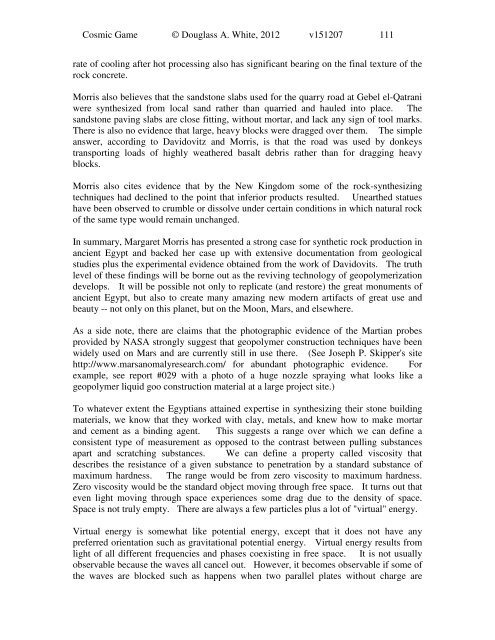You also want an ePaper? Increase the reach of your titles
YUMPU automatically turns print PDFs into web optimized ePapers that Google loves.
<strong>Cosmic</strong> <strong>Game</strong> © Douglass A. White, 2012 v151207 111<br />
rate of cooling after hot processing also has significant bearing on the final texture of the<br />
rock concrete.<br />
Morris also believes that the sandstone slabs used for the quarry road at Gebel el-Qatrani<br />
were synthesized from local sand rather than quarried and hauled into place. <strong>The</strong><br />
sandstone paving slabs are close fitting, without mortar, and lack any sign of tool marks.<br />
<strong>The</strong>re is also no evidence that large, heavy blocks were dragged over them. <strong>The</strong> simple<br />
answer, according to Davidovitz and Morris, is that the road was used by donkeys<br />
transporting loads of highly weathered basalt debris rather than for dragging heavy<br />
blocks.<br />
Morris also cites evidence that by the New Kingdom some of the rock-synthesizing<br />
techniques had declined to the point that inferior products resulted. Unearthed statues<br />
have been observed to crumble or dissolve under certain conditions in which natural rock<br />
of the same type would remain unchanged.<br />
In summary, Margaret Morris has presented a strong case for synthetic rock production in<br />
ancient Egypt and backed her case up with extensive documentation from geological<br />
studies plus the experimental evidence obtained from the work of Davidovits. <strong>The</strong> truth<br />
level of these findings will be borne out as the reviving technology of geopolymerization<br />
develops. It will be possible not only to replicate (and restore) the great monuments of<br />
ancient Egypt, but also to create many amazing new modern artifacts of great use and<br />
beauty -- not only on this planet, but on the Moon, Mars, and elsewhere.<br />
As a side note, there are claims that the photographic evidence of the Martian probes<br />
provided by NASA strongly suggest that geopolymer construction techniques have been<br />
widely used on Mars and are currently still in use there. (See Joseph P. Skipper's site<br />
http://www.marsanomalyresearch.<strong>com</strong>/ for abundant photographic evidence. For<br />
example, see report #029 with a photo of a huge nozzle spraying what looks like a<br />
geopolymer liquid goo construction material at a large project site.)<br />
To whatever extent the Egyptians attained expertise in synthesizing their stone building<br />
materials, we know that they worked with clay, metals, and knew how to make mortar<br />
and cement as a binding agent. This suggests a range over which we can define a<br />
consistent type of measurement as opposed to the contrast between pulling substances<br />
apart and scratching substances. We can define a property called viscosity that<br />
describes the resistance of a given substance to penetration by a standard substance of<br />
maximum hardness. <strong>The</strong> range would be from zero viscosity to maximum hardness.<br />
Zero viscosity would be the standard object moving through free space. It turns out that<br />
even light moving through space experiences some drag due to the density of space.<br />
Space is not truly empty. <strong>The</strong>re are always a few particles plus a lot of "virtual" energy.<br />
Virtual energy is somewhat like potential energy, except that it does not have any<br />
preferred orientation such as gravitational potential energy. Virtual energy results from<br />
light of all different frequencies and phases coexisting in free space. It is not usually<br />
observable because the waves all cancel out. However, it be<strong>com</strong>es observable if some of<br />
the waves are blocked such as happens when two parallel plates without charge are





